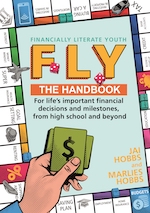Talking to anyone about money is difficult at the best of times, let alone children, but there is so much we can teach our children to help build their financial literacy.
Here’s how to avoid the 5 mistakes parents make when teaching children about money.
1. Making money talk taboo
Often in the past, children speaking about money has been taboo, and parents would respond with “that’s none of your business”. Those children would then fly the nest completely unprepared for what was ahead of them.
Thankfully, times are changing, and parents and children are having more open and transparent conversations about money, helping prepare them for life on their own.
The dining table and car rides are a great place to have these conversations. Welcome questions from your children about money and how the world works. Encourage those questions and conversations to help empower and prepare your children for life when they no longer have the security of being tucked safely under your wing.
Being financially literate from an early age can only be a positive, with effects such as:
- Increased motivation
- Goal-setting skills
- Work ethic
- Sense of security/understanding/empowerment
- Increased sense of reality
- Appreciation
- Less entitled mindset
- Increased initiative/responsibility
- Sense of purpose
- Sense of contribution
2. Failing to teach children financial literacy basics
I think we can often over-complicate money talk with our children, which makes us stall and not know where to start. That’s why we came up with these five simple principles for educating our children on the foundations of financial literacy:
- What is the purpose of money? A currency that is exchanged for products and services.
- What is the form and function of money? Cash, eftpos/savings and credit.
- What is the value of money? Help them understand what things cost and relate that back to the things they want and their earnings from pocket money or jobs.
- How to earn money? Pocket money, jobs, extra jobs, side hustles, and have open conversations about the many and varied, wild and wonderful ways that other people earn money.
- Spend less than you earn and develop a strong savings habit. Keep it very simple. Start young at 50% spend 50% savings, and adjust that as they get older once the savings habit is well understood and established.
See what resonates with you and develop your own simple structure to help guide you to support your children and the development of their financial literacy knowledge.
3. Not caring enough about your future self
Caring about our future selves is not a natural human response but one that can be learnt and is essential for success. It is important to lead by example and help our children understand why they need to care more about their future selves as well.
This is why we wrote FLY: Financially Literate Youth, a handbook for young people to help educate and empower them for their own financial journey. Whilst it’s aimed at teenagers, there is no age too young to start these conversations with our children.
When writing FLY I took a particular interest in why we aren’t all more concerned about our financial future and take our financial literacy education more seriously from an earlier age. An article by Raiz Invest covered the subject well and here’s a summary of what it said:
- Several studies have revealed that we often treat our future selves like complete strangers. That’s one of the reasons why we find it hard to save or choose a salad over a burger.
- Our brains are hardwired to not think about future you. Studies found that thinking about your current self triggers different brain regions than when thinking about your future self. Thinking about future you actually activates the same areas of the brain as when we think about other people. This means our brain transmits present and future consequences to different parts of our brain. While you may know the benefits of helping future you now, you are unlikely to feel it and therefore act on it.
- We prefer definite over indefinite options. Heard of the marshmallow test? It’s an old study whereby children are offered one marshmallow now or two if they wait 15 minutes. Google it and you’ll find some funny videos. No doubt some children were wondering, Is there a guarantee there’s really going to be double the number of marshmallows if we wait? Studies showed there are many situations in which children can’t be certain that they would receive the delayed outcome and therefore opt for an immediate result. However, as we develop into adults, this is a thinking pattern we can learn to be aware of and fight off, in order to avoid the temptations of instant gratification.
So, as you approach life and financial decisions, think about how you would like your future person to be looked after. What things in life do they deserve? When you make decisions, run them by your future self too. Would they think that wise or a wasted opportunity?
Then, teach this valuable lesson to your children, so they too can learn to care more about their future selves.
4. Failing to guide
It’s tempting to try and influence our children into a future career or direction that makes sense to us as parents or fill a void we feel we couldn’t quite fill for ourselves. Instead, we should be empowering our children to become educated, empowered and independent and to forge their own unique path in life.
We are all on a unique journey in life in a complex, dynamic and forever changing world. Opportunities are infinite.
Our role as parents is to guide our children the best we can, with the knowledge we have. We mustn’t be tempted to tell it to them as though we know best or our way is the only way. We are all forever learning, growing and changing with different life experiences and perceptions. We should be empowering children to think for themselves, trust their own instincts and to have the courage to pursue their individual dreams and passions.
5. Not utilising reading time wisely
In primary school there is plenty of pressure on parents to be reading with our children, and rightfully so. Why not put this time to good use by carefully selecting the books you read together.
From an early age, my boys have loved Kobi Yamada’s books, especially Maybe and What do you do with an idea?. They are inspirational and empowering and reading them makes me feel good too.
As they get older, enjoy biographies of their favourite sports stars or books about the history behind one of their passions. Financial literacy is woven into these in a way that brings context and meaning for their future. It helps bring together these life skills lessons, of which financial literacy forms a major part.
Marlies and Jai Hobbs’ new book, FLY: Financially Literate Youth, is out now.
How helpful was this article?
Click on a star to rate it!
5 / 5. 3
Be the first to rate this post!
Marlies & Jai Hobbs
Related posts
Subscribe
Receive personalised articles from experts and wellness inspiration weekly!



